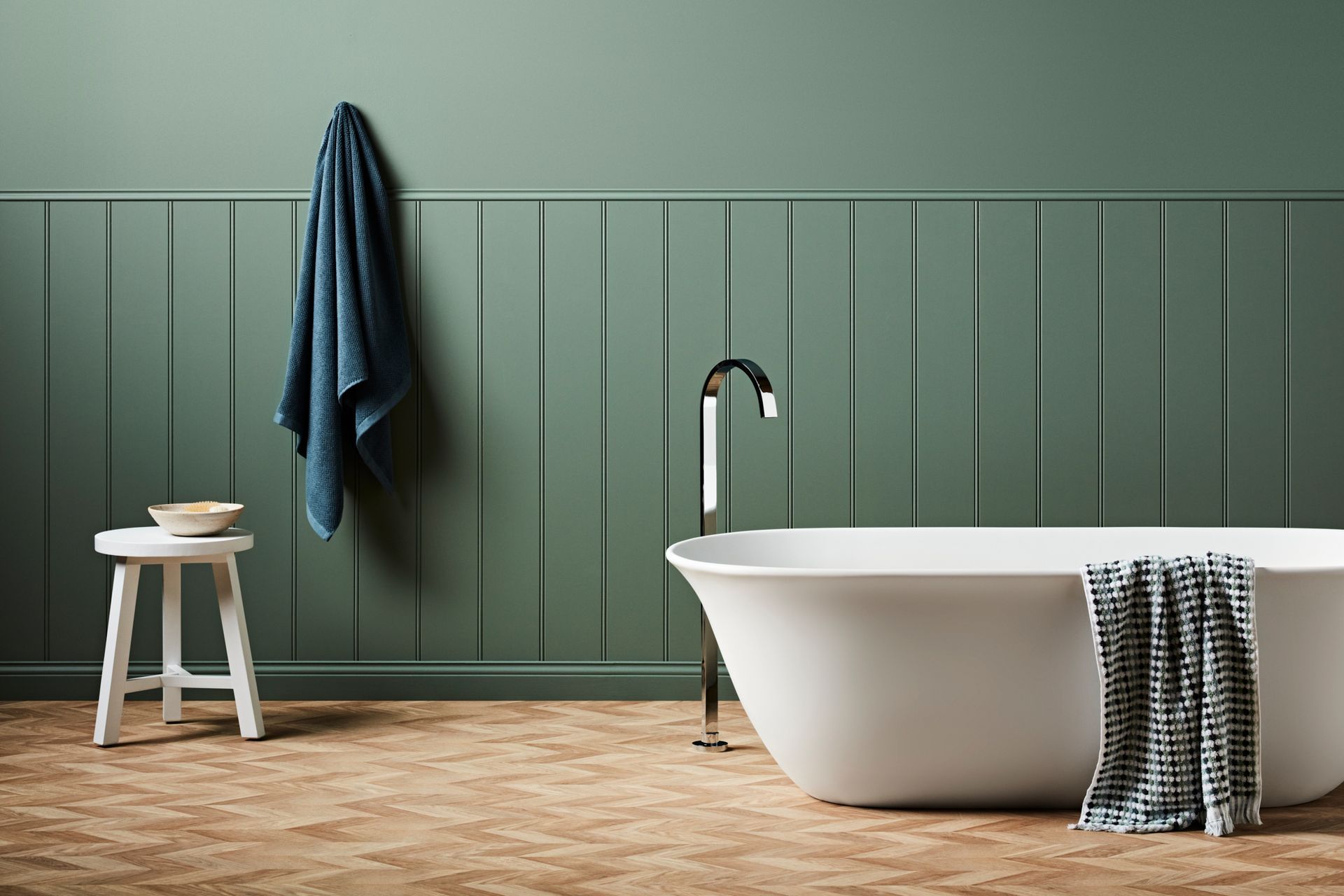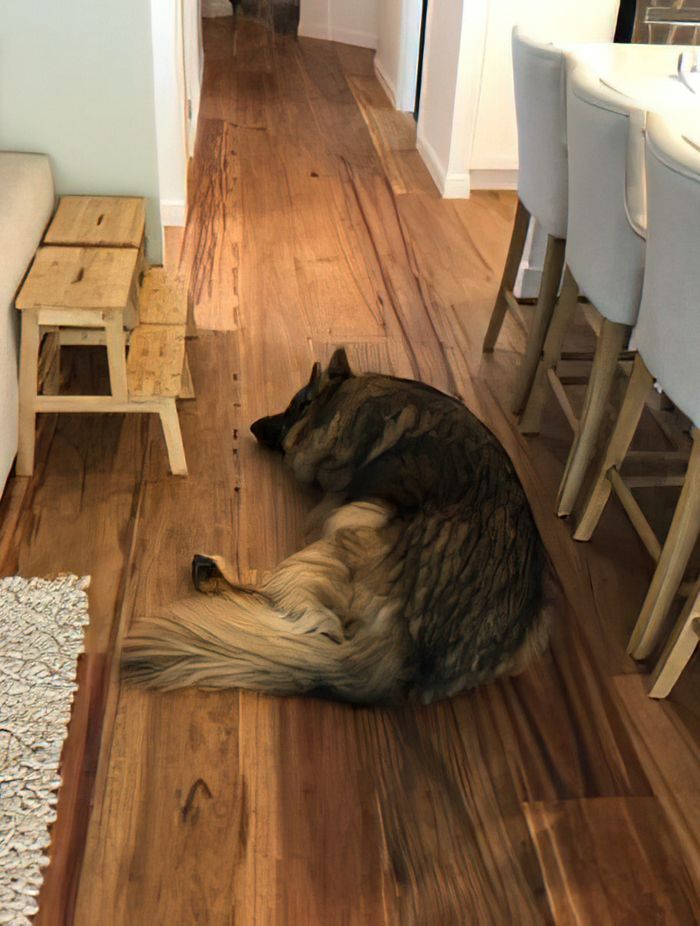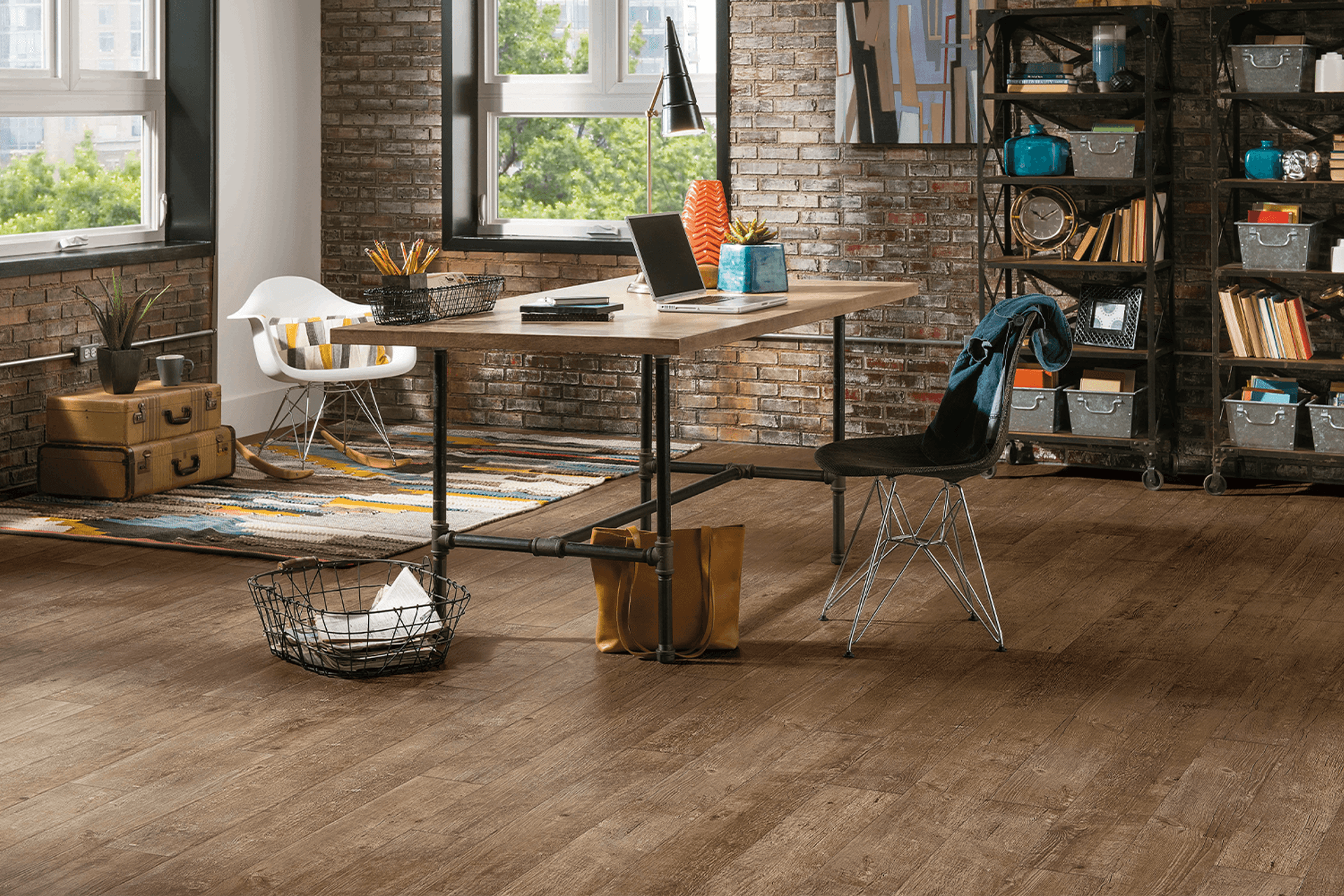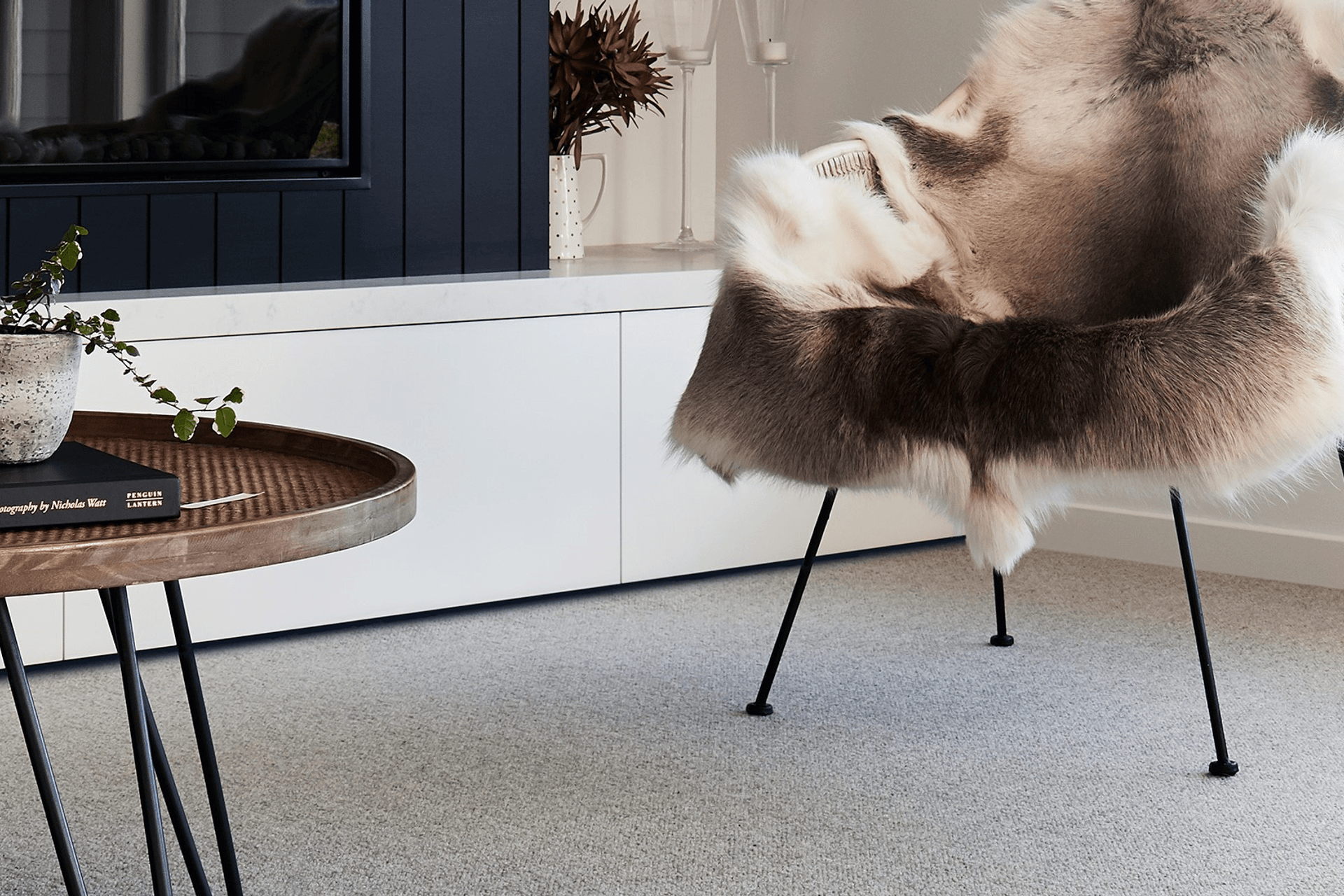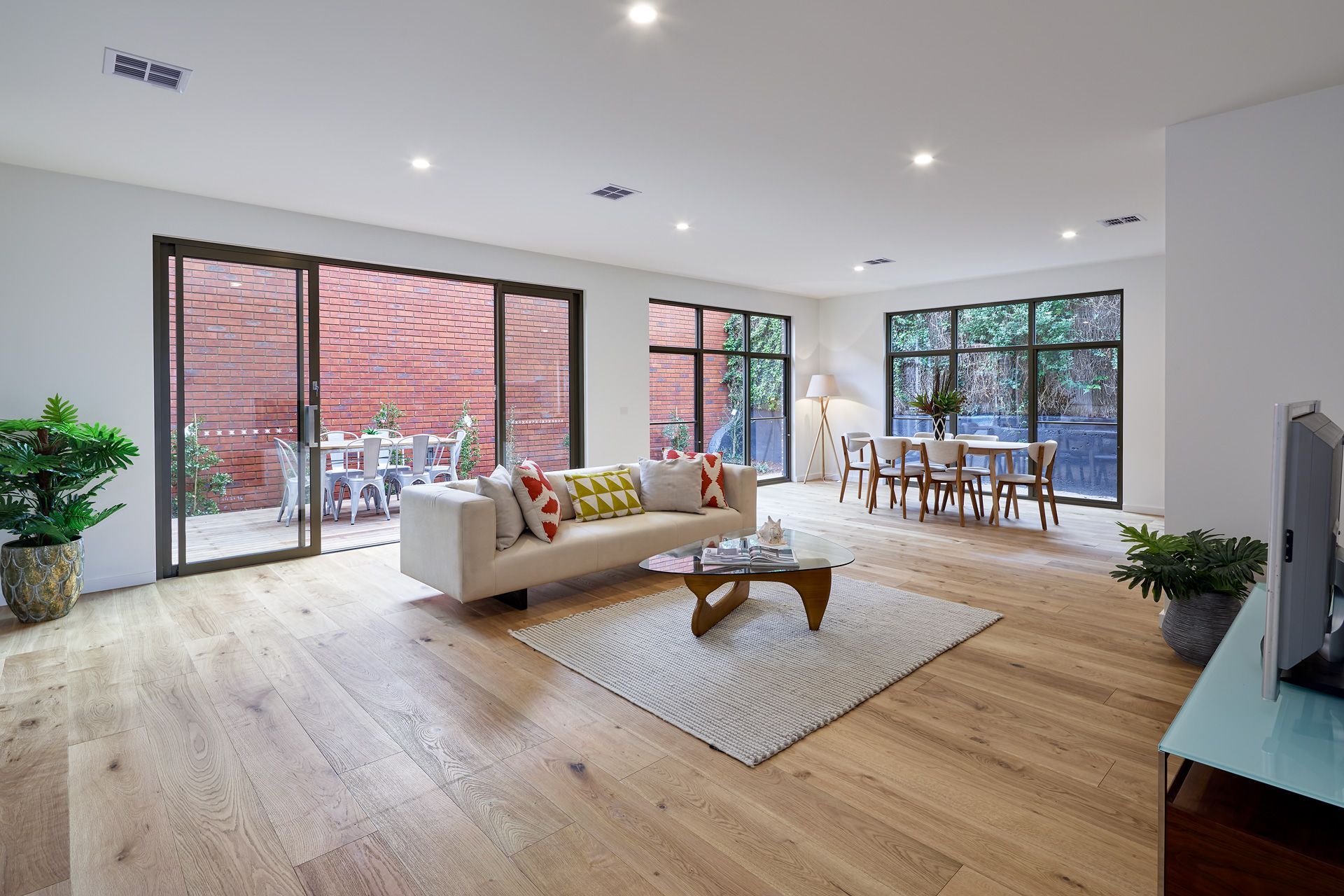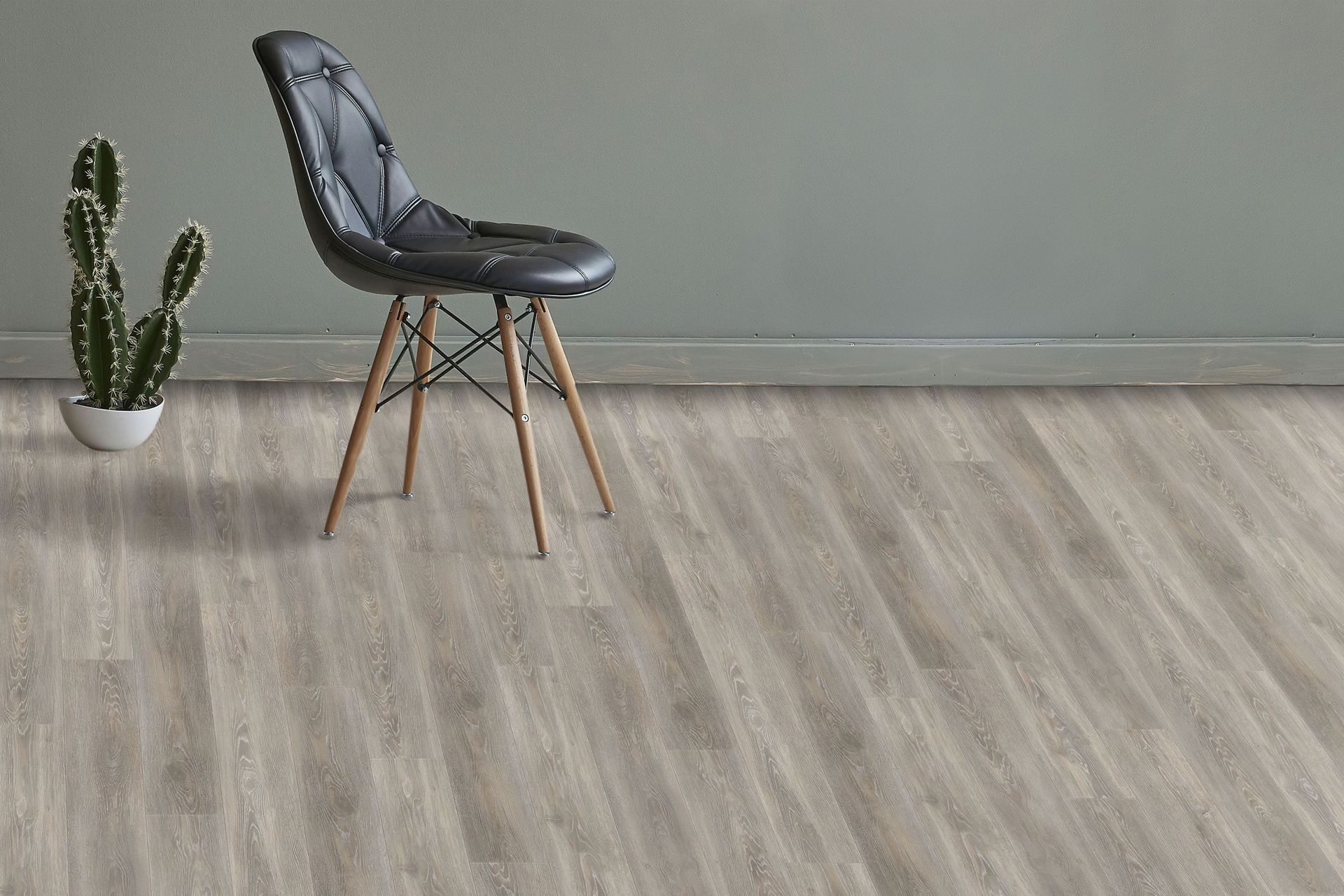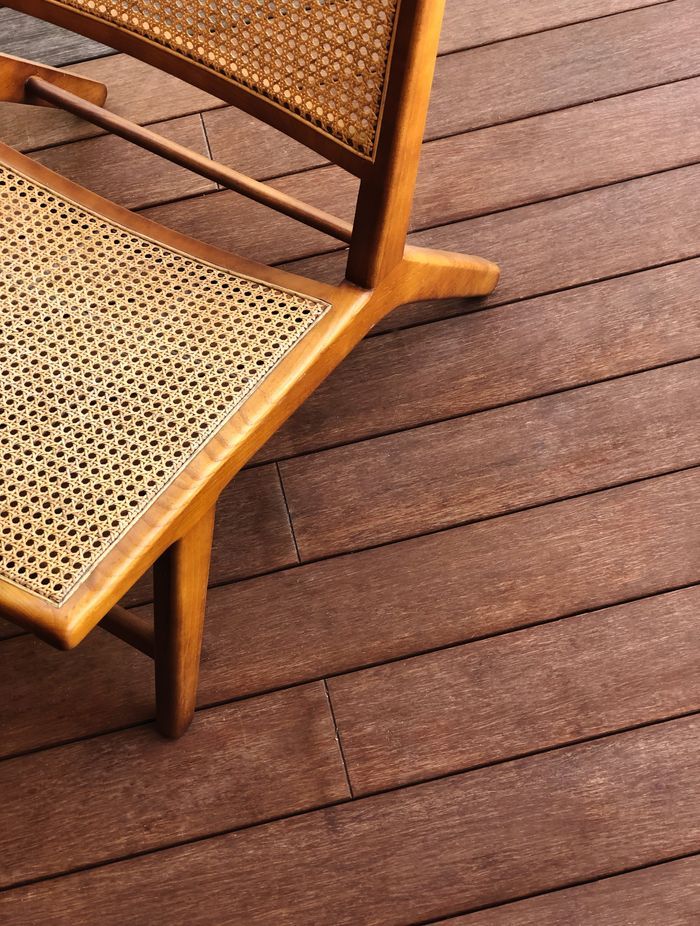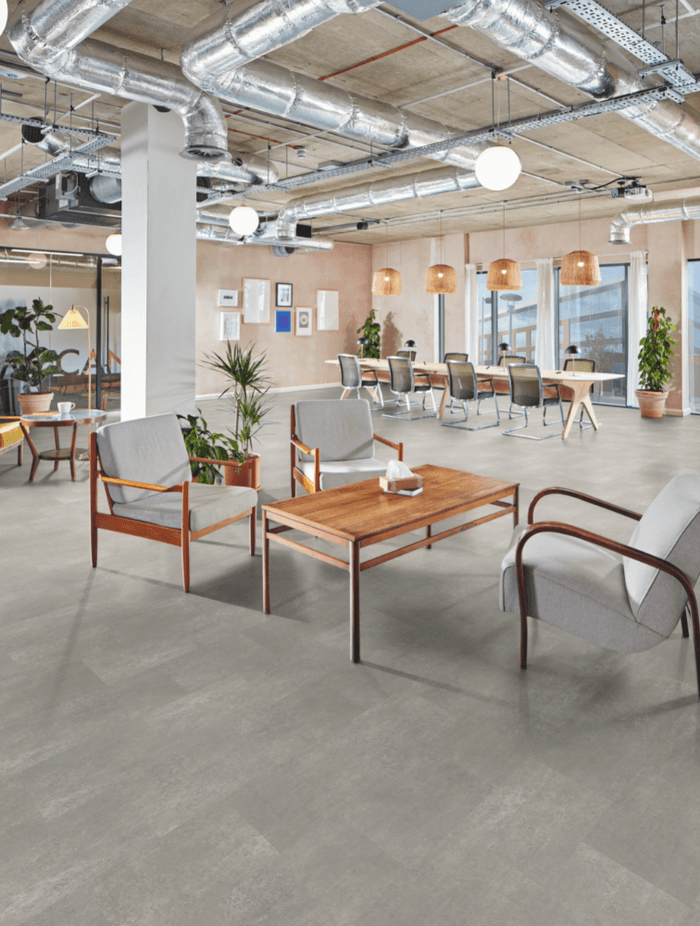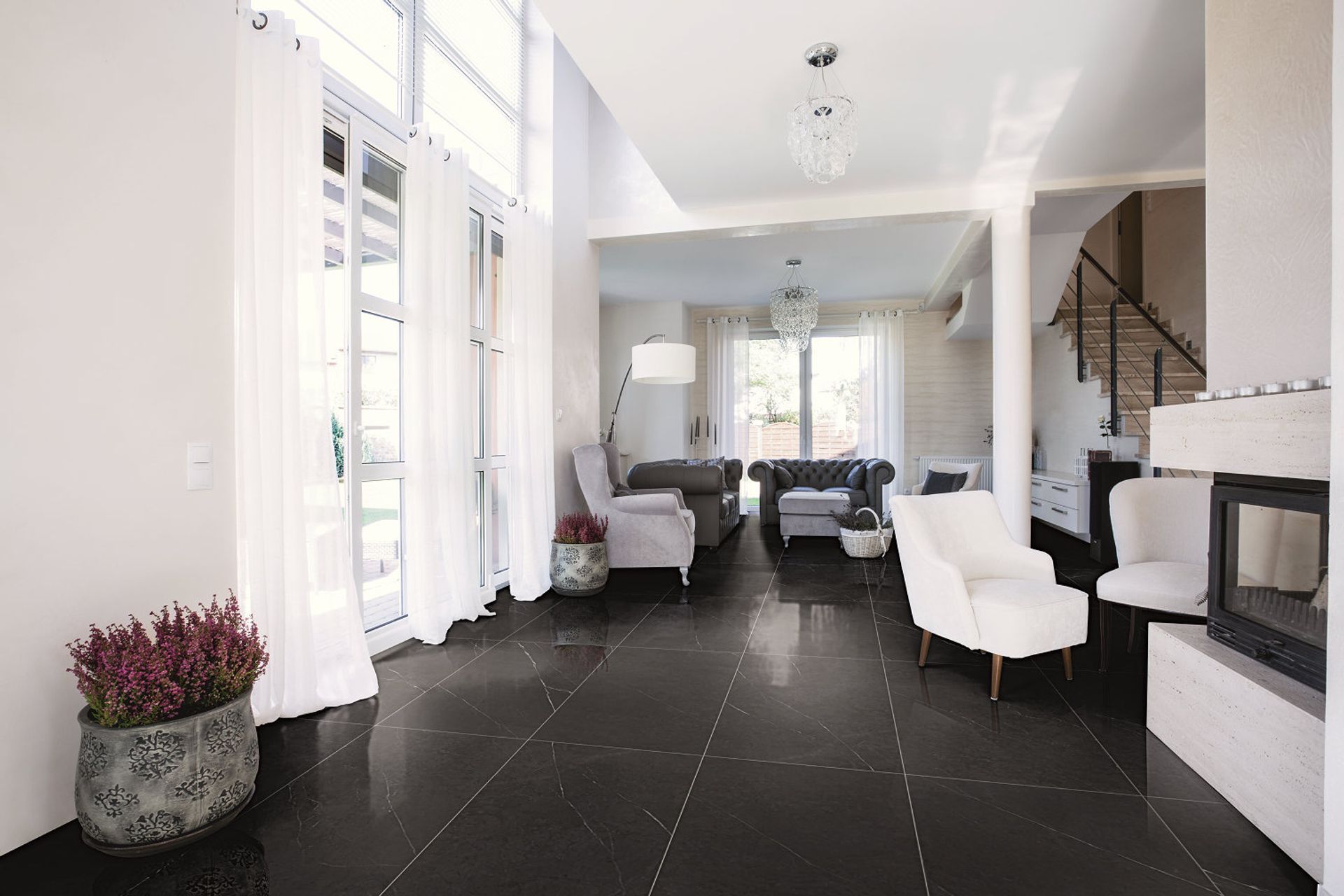11 popular types of flooring to consider for your home
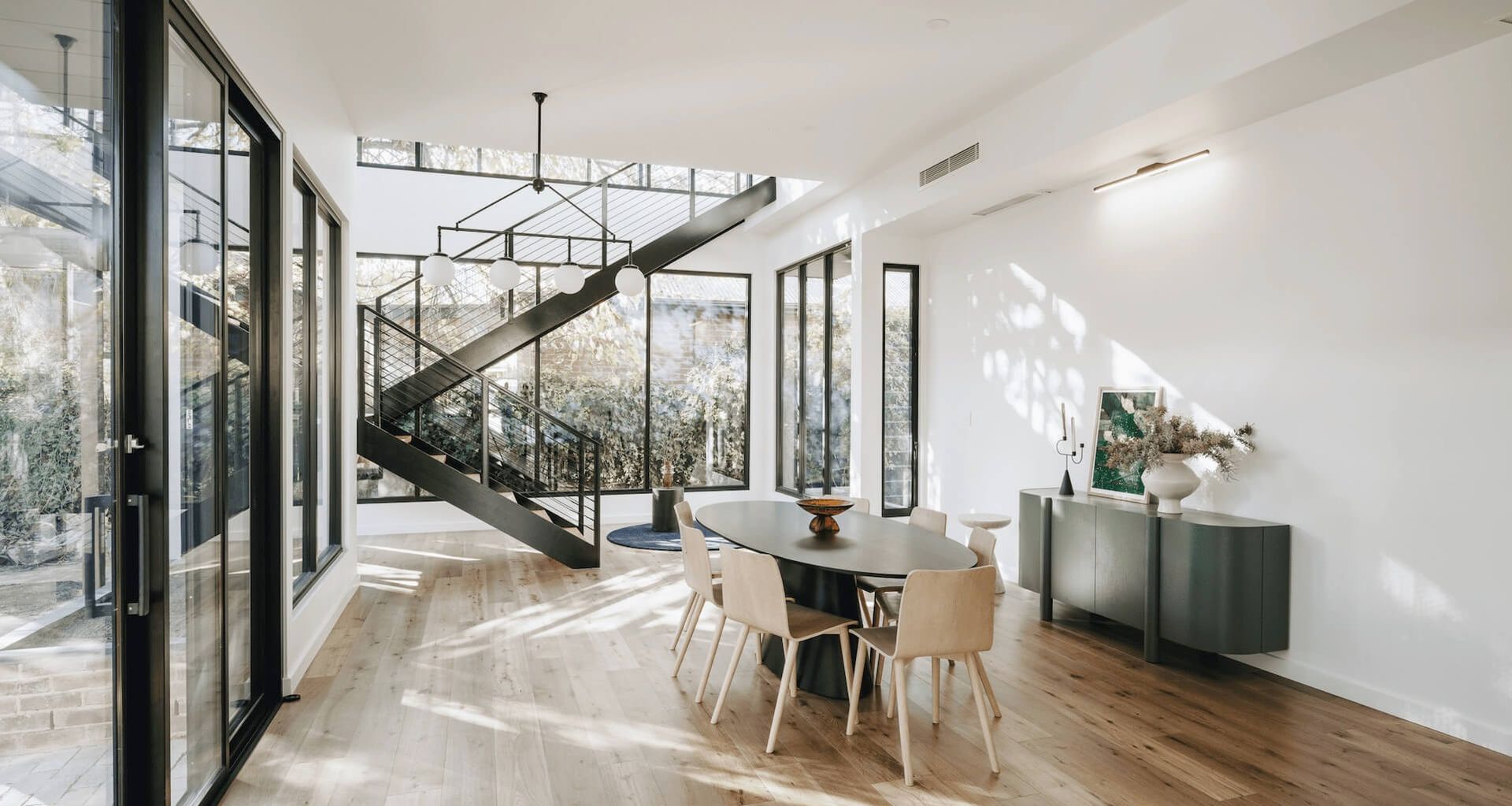
Selecting a new floor is a significant decision that can impact the style and practicality of the room you're installing. There are a lot of options available, and before coming to a final decision, it is important to be aware of what you have to choose from, the unique characteristics and drawbacks of these choices and the factors you need to consider when you're weighing up a purchasing decision to make the best choice.
The most popular types of flooring in Australia
1. Laminate flooring
Laminate flooring is a type of composite flooring that consists primarily of a core layer made from plywood or fibreboard. This core layer forms the base of the flooring. In some designs, an additional layer, known as underlayment, may be applied beneath the core layer to provide extra insulation and enhanced protection against moisture and sound. Above the core layer, a high-resolution image of the desired appearance, such as wood or natural stone, is printed on an image layer. This image layer is then sealed with a protective overlay to ensure resistance to wear and tear.
Advantages and disadvantages of laminate flooring
Advantages
Easy to clean
Laminate flooring has strong protective layers that help keep scuffs and stains away from the surface, so it's easy to keep sparkling. All you need to do is sweep up any dirt and dirt once a week and clean it with a damp microfibre mob on a regular basis to keep it looking its best.
DIY friendly and simple to install
Most laminate flooring options come with a click-lock design, allowing the planks to easily snap together without the need for glue or nails. This floating floor system sits over your existing floor, meaning there's no need for a tedious tear-out of the old flooring. With just a few basic tools, such as a saw for cutting planks to fit, a tape measure, and a rubber mallet, even those with minimal DIY experience can achieve a professional-looking finish.
Cost
The cost of laminate flooring can depend on the material you want to mimic. However, it's generally cheaper than the real thing. For example, laminate flooring that looks like a type of hardwood floor is less expensive than a genuine hardwood floor.
Disadvantages
Can't be refinished
Unlike some other types of flooring such as hardwood varieties, laminate flooring can't be sanded down or refinished. Once its worn down and cosmetic damage shows the flooring needs to be replaced or repaired.
Can be susceptible to water damage
As the core layer of laminate floors is made from fibreboard any extended exposure to moisture can cause the floor to swelling, warping and mould growth. One way to avoid this is to ensure any laminate flooring product you consider is properly sealed with water resistant coatings .
Sound and feel underfoot
If you've ever walked on laminate flooring you may have sometimes noticed it producing a hollow sort of sound. This is caused by the floor not being installed with the proper underlayment. And as a composite material it may not feel as warm or as comfortable underfoot as a wooden or carpet floor.
2. Hardwood flooring
Hardwood flooring consists of pieces solid wood which are cut into planks or tiles. Hardwood floors consist of various forms of hardwood such as oak, walnut, jarrah and more. The planks or tiles are then finishes with a coating to protect their surface, and improve their appearance.
Advantages and disadvantages of hardwood flooring
Advantages
Highly desired appearance
No other flooring type compares to the distinct look that forms of hardwood can provide. The beauty of a natural material is that every plank is different and has a distinct look that can't be replicated. Hardwood floors also connotate a sense of cosiness that laminate or carpet can't compete with.
Impressive lifespan
Hardwood was used as flooring long before the advent of other materials, and it can last for decades as long as it is cared for. Most experts recommend refinishing hardwood floors every 10 years or so to keep them looking good. Refinishing typically entails sanding and applying a new coat of finish.
Versatile
Hardwood floors look good in pretty much any room. They also provide a neutral background that suits a wide variety of interior design styles, whereas other options, like carpet, typically have to suit the room's colour scheme.
Disadvantages
Cost
Though hardwood floors can provide a positive return on investment, the upfront costs are higher than other flooring types.
Wear and tear
One of the downsides of natural materials is that they can be more susceptible to damage, such as scratches or gouges than laminate flooring due to the lack of wear-resistant layer. Changes in humidity can also cause hardwood floors to splinter and warp. Damage can be mitigated with regular refinishing though.
Noise
Hardwood floors are bound to creak when you walk around them. The noise can be reduced by filling gaps between the subfloor and joists with construction adhesive, but it's challenging to eliminate it.
3. Vinyl flooring
Vinyl flooring is a synthetic flooring material made from PVC and other compounds. It comes in various forms including sheets, tiles and planks. Similar to laminate flooring the vinyl can mimic the appearance of natural materials, through high-resolution imaging and embossing techniques.
Advantages and disadvantages of vinyl flooring
Advantages
Superior moisture resistance
Vinyl flooring is highly water resistant and is often used in inherently wet areas such as bathrooms and laundry rooms without concern for water damage. It can withstand spills and humidity without warping or developing mould.
Design versatility
Vinyl flooring can mimic the appearance of materials such as forms of hardwood and natural stone, so it can be used in various interior settings. Its a great option for buyers who want the look of a natural material but don't have the budget for a natural hardwood or stone.
Comfort underfoot
Due to its PVC construction and foam backing layers that provide a cushioning effect, vinyl flooring is softer and warmer underfoot compared to surfaces such as tile or stone.
Disadvantages
Can't be refinished
Once the surface layer of a plank of vinyl flooring is scratched, worn, or dulled, the entire section needs to be replaced because the decorative layer is only on the surface. You cannot sand vinyl flooring, like you can with hardwood flooring, so its longevity is typically less than that of hardwood flooring.
Perceived value
While vinyl can mimic natural materials it can't fully replicate feel or value of genuine materials. However, its worth remembering that vinyl flooring does have a lower price point.
Related article: Vinyl flooring price in Australia: A 2024 breakdown
4. Carpet flooring
Carpet is a type of floor covering made from woven or tufted fibres or yarns and is typically attached to a flexible backing. It comes in various materials, including wool, nylon, polyester, and polypropylene, each offering different textures, colours, and durability levels. Carpet is commonly used in residential settings, such as bedrooms and living rooms, as well as in commercial spaces that require noise reduction and a comfortable walking surface.
Advantages and disadvantage of carpet flooring
Advantages
Comfort and warmth
Carpet provides a soft, cushioned feel underfoot, making it comfortable to walk, sit, and even lie on. It also acts as an insulator, helping to retain warmth in a room, which can contribute to a cosy and inviting atmosphere, especially in colder climates.
Noise reduction
Thanks to its fibrous material, carpet is excellent at absorbing sound - its fibrous nature allows it to trap air with in its structure, disrupting and absorbing soundwaves.
Safety
Carpet flooring reduces the risk of slips and falls, making it a safer option especially in homes with young children or elderly individuals. In the event of a fall, carpet provides a softer landing surface, which can help prevent serious injuries.
Disadvantages
Maintenance and cleaning
Carpets can trap dust, allergens, and dirt more easily than hard surface flooring, requiring regular vacuuming and professional cleaning to maintain air quality and appearance. Spills and stains can also be more challenging to remove, and you may need specialist cleaning substances to remove these spills and stains.
Moisture sensitivity and mould growth
Carpet is not suitable for areas prone to moisture, such as bathrooms and basements, as it can absorb water and become a breeding ground for mould and mildew. This can lead to unpleasant odours and potential health risks if not addressed.
Wear and longevity
While the lifespan of carpet flooring can vary depending on the material and quality, it generally does not last as long as some hard surface options. High-traffic areas can show signs of wear, including matting, fading, and fraying, requiring replacement sooner than other flooring types.
Related article: How to choose the right type of carpet for your home
5. Engineered flooring
Engineered flooring is constructed from several layers of materials bonded together to form a plank. The top layer is a thin slice of real hardwood or stone, giving the flooring its natural appearance and texture. This layer is supported by multiple layers of plywood or high-density fibreboard (HDF) beneath it, which constitute the core of the plank. This core is designed to provide dimensional stability, reducing the risk of the flooring warping or expanding due to changes in humidity and temperature, which can be a risk with traditional hardwood floors.
Advantages and disadvantages of engineered flooring
Advantages
Wide selection of finishes
Engineered flooring encompasses a wide range of stylistic options that mimic the appearance of other flooring options, particularly those made from natural materials, such as wood and natural stone.
Range of colours and patterns
Just as a range of finishes are available, engineered flooring comes in various colours and patterns, from natural tones to dark, rich stains. The technology behind engineered flooring allows for a wide variety of patterns, including traditional straight planks, herringbones, chevrons, and other custom layouts.
Adaptive use
Engineered floors often come with click-lock installation systems that allow for easier DIY installation, removal, and replacement. This system is fantastic for homeowners who want to update their floors without committing to a permanent change.
Disadvantages
Limited refreshing options
The possibility of sanding and refinishing engineered flooring depends on the thickness of the top veneer layer. While high-quality engineered floors can be refinished once or twice, cheaper options with thinner veneer cannot be sanded down without risking damage to the floor.
Variable product quality
The engineered flooring market offers products ranging from high to low quality. Floors at the lower end of this spectrum may not provide the same level of performance or visual richness as their higher-end counterparts.
6. Floating floors
Floating floors, also known as "click-lock" floors, are a popular choice for their ease of installation and versatility. These floors are designed to "float" over an underlay, without being nailed or glued directly to the subfloor. Floating floors come in various materials, including laminate, engineered wood, and luxury vinyl planks (LVP). They are particularly well-suited for installations over concrete slabs or existing hard surfaces, making them an excellent option for renovations or homes with problematic subfloors.
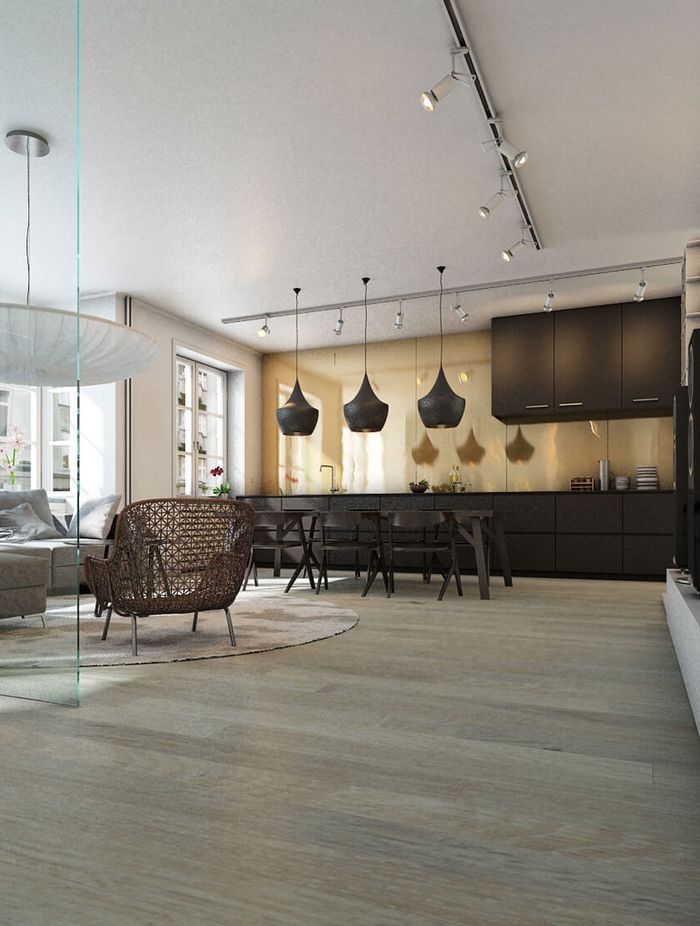
Advantages
Ease of installation
Floating floors are designed for quick and easy installation, with planks that simply click together and lay over an underlay. This feature significantly reduces the time and cost associated with installation, making it an accessible DIY project for many homeowners.
Versatility over different subfloors
These floors can be installed over nearly any existing floor type, such as concrete, ceramic tile, or even existing wood floors. This adaptability makes floating floors an excellent choice for updating the look of a space without the need for extensive subfloor preparation.
Thermal and acoustic insulation
Floating floors are often installed over a layer of underlayment, which can provide additional insulation against cold and help reduce noise transmission. This makes floating floors a comfortable and quiet flooring option, enhancing the living environment.
Disadvantages
Vulnerability to temperature fluctuations
The materials used in floating floors can expand and contract with changes in temperature. This movement, while typically accommodated by the flooring's design, can lead to long-term issues if not properly managed, such as gaps or buckling.
Wear and tear over joints
The interlocking joints of floating floors can be susceptible to increased wear, particularly in areas with heavy foot traffic. Over time, this can lead to the deterioration of the locking mechanism, affecting the floor's overall appearance and stability.
Difficulty with repairs
While the installation and replacement of floating floors are generally easier, localised damage can be more challenging to address. Repairing or replacing damaged sections without affecting the surrounding area requires carefully disassembling and reassembling the interlocking planks, which can be time-consuming and may not always result in a complete fix.
7. Hybrid flooring
Hybrid flooring is a versatile 'hybrid' that combines a range of materials, including polyvinyl chloride (PVC) and either wood fibres or stone plastic composite (SPC), creating a core that is exceptionally stable, durable, and waterproof. This core layer, crafted for enhanced performance, sets hybrid flooring apart by providing resistance to temperature changes and moisture, making it suitable for a range of environments.
Topped with a specialised wear layer resistant to scratches, dents, and stains, hybrid flooring stands up well to high-traffic demands. It mimics the appearance of natural materials with remarkable accuracy through sophisticated photographic technology, offering an array of design options.
Advantages and disadvantages of hybrid flooring
Advantages
Enhanced moisture resistance
Hybrid flooring is designed with a core that combines the best properties of laminate and vinyl, leading to superior moisture resistance compared to traditional hardwood or laminate. This core often includes materials such as stone plastic composite (SPC) or wood plastic composite (WPC), which do not swell or deform easily upon exposure to moisture. This makes hybrid flooring a reliable option for areas like bathrooms and kitchens where water spills are common.
Thermal insulation
The composite nature of hybrid flooring materials can offer better insulation against cold, potentially contributing to energy savings by reducing the need for heating. Additionally, some hybrid flooring products are engineered with built-in underlays that can improve acoustic performance, reducing the transmission of sound between floors—a benefit for multi-story living environments.
Ease to care for
The top wear layer of hybrid flooring is specifically treated to resist stains and scratches, facilitating easier cleaning and maintenance. This surface treatment also makes hybrid floors a hygienic option, as it can prevent the growth of mould and bacteria which are more likely to occur in natural materials when exposed to moisture.
Disadvantages
Potential noise concerns
If not installed with an adequate acoustic underlay, hybrid flooring can produce more noise when walked on compared to softer flooring options like carpet. This is due to its hard surface, which can amplify sounds such as footsteps, potentially creating a less serene environment without the correct installation measures.
Environmental and health considerations
The manufacturing process of some hybrid flooring components can involve chemicals and plastics that raise environmental and health concerns. For instance, the production of vinyl (a common component in hybrid floors) can release dioxins, which are harmful to both human health and the environment. Moreover, considerations around the life cycle of these materials, including recyclability and disposal, are important factors for environmentally conscious consumers.
Design limitations
While hybrid flooring can mimic the look of wood or stone, it may not fully replicate the natural beauty and feel of these materials. For some homeowners, the authenticity of real hardwood or stone might be preferred for aesthetic or resale value considerations.
Related article: Hybrid Flooring: Pros, Cons and Applications
8. Bamboo flooring
Bamboo flooring is a popular choice for eco-conscious consumers, derived from the bamboo plant, specifically the species Moso bamboo, which is predominantly grown in China and other parts of Asia. The manufacturing process transforms this fast-growing grass into flooring that resembles traditional hardwood floors but comes from a more sustainable source. Bamboo for flooring is typically harvested at its peak density and strength, around five to six years after planting.
It usually comes in planks, in free forms: solid bamboo planks, engineered bamboo planks and strand woven planks.
Advantages and disadvantages of bamboo flooring
Advantages
Bamboo is a renewable resource
Bamboo is a highly renewable and sustainable material, as it grows rapidly and can be harvested without causing extensive environmental damage.
Hardness and resilience
Bamboo floors are known for their exceptional hardness, making them resistant to dents, scratches, and withstanding consistent usage in busy areas.
Temperature regulation
Bamboo has natural insulating properties that can help regulate indoor temperatures, potentially reducing energy costs for heating and cooling.
Disadvantages
Sensitive to moisture
Bamboo is susceptible to moisture damage, swelling, and warping when exposed to excessive humidity or water. This can be problematic in bathrooms, laundry rooms, or areas with high moisture levels.
Limited colour options
Bamboo flooring is available in a limited range of natural colours, primarily shades of brown and tan. This may not suit every interior design style or preference.
Potential for surface imperfections
While bamboo floors are hard, they can still develop surface imperfections or marks from heavy furniture or sharp objects over time.
9. Glass flooring
Glass flooring incorporates engineered glass to create surfaces capable of supporting human activity, similar to traditional floors but with the unique feature of translucency or transparency. This architectural element is crafted using processes that strengthen the glass, making it suitable for areas where it will be walked on.
The use of such flooring adds a visual dimension to spaces by allowing light to pass through, which can enhance the overall design. Safety features, including slip-resistant coatings, are integral to its design to ensure it meets the functional requirements of environments with regular use.
Advantages and disadvantages of glass flooring
Advantages
Light enhancement
Glass floors enhance natural and artificial lighting, creating a bright, open atmosphere. This feature can make spaces appear larger and more inviting by maximising light transmission.
Strength and low maintenance
Properly treated glass floors are resilient, resistant to scratches, and easy to clean. Their non-porous nature means they don’t hold dust, allergens, or mould, simplifying upkeep.
Custom design options
The adaptability of glass allows for various customisations, including opacity levels, colours, and patterns. This enables unique design solutions tailored to different themes and preferences.
Disadvantages
Potential for slips
Glass can be slippery, especially when wet. Although treatments can improve grip, slipperiness remains a concern in areas prone to moisture.
Privacy and comfort issues
Transparent glass floors might not be suitable where privacy is a priority. They can also feel cold underfoot, which might affect comfort in colder environments or require additional heating solutions.
10. Concrete flooring
Concrete flooring refers to a floor surface made from concrete, a composite material composed primarily of water, cement, and aggregate (like sand, gravel, or crushed stone). Once mixed, the concrete is poured, smoothed, and finished to create a solid, durable floor surface. Concrete floors can be left in their natural state or treated with various colours, textures, and finishes to enhance their appearance and design. This type of flooring is popular in residential and commercial settings due to its longevity, ease of maintenance, and the wide range of options available through different finishing techniques.
Advantages and disadvantages of concrete flooring
Long-lasting nature
Concrete floors are exceptionally resilient against wear and tear. They are capable of enduring the stress from heavy equipment, making them suitable for various settings, including commercial and industrial areas. With proper installation and care, these floors can remain in excellent condition for the entire lifespan of the building.
Design flexibility
Concrete offers a canvas for a broad range of colours, textures, and finishes. Modern techniques enable concrete floors to replicate the appearance of natural stone, brick, or wood, catering to diverse design requirements.
Straightforward maintenance
Compared to other flooring options, concrete floors are straightforward to maintain. They resist stains and do not attract allergens, simplifying cleaning processes. A simple routine of dust mopping and occasional wet mopping with mild detergents can keep these floors looking pristine.
Disadvantages
Temperature sensitivity
Concrete floors tend to be cool to the touch, particularly in colder months, which may be uncomfortable in residential environments. While this can be somewhat mitigated with area rugs or underfloor heating systems, it remains a consideration for those in cooler climates.#
Potential for moisture issues
Without proper sealing or if the slab is in contact with ground moisture, concrete floors can become damp. This condition can encourage the growth of mould or mildew and, in areas with high humidity, can lead to slippery surfaces due to condensation.
Related article: Choosing the perfect polished concrete floor finish for your space
11. Tile flooring
Tile flooring refers to a floor surface constructed from individual pieces of hard-wearing material such as ceramic, porcelain, stone, or glass. These pieces are typically shaped into squares or rectangles and are available in a variety of sizes, colours, and designs. This type of flooring is often selected for its practical benefits in spaces where water resistance or ease of cleaning is desired.
Advantages and disadvantages of tile flooring
Advantages
Water resistance
Tiles, especially ceramic and porcelain, offer excellent resistance to water and moisture. This makes tile flooring an ideal choice for areas like bathrooms, kitchens, and laundry rooms where spills and humidity are common.
Ease of cleaning
Tile floors can be relatively straightforward to maintain. Spills and dirt can be easily wiped or swept away. This quality makes tile a practical flooring option for maintaining cleanliness in spaces that are frequently used or prone to messes.
Cooling property
In climates with hot weather, tile floors can help in keeping indoor spaces cooler. The natural coolness of tiles can contribute to a more comfortable and temperate indoor environment without relying heavily on air conditioning.
Disadvantages
Hardness and discomfort
Tile floors are very hard, which can be uncomfortable to stand on for prolonged periods. This may necessitate the use of rugs or mats in areas where you spend a lot of time standing, such as in front of kitchen counters.
Coldness in cooler climates
While beneficial in hot climates, the inherent coolness of tile can be a disadvantage in colder settings, making floors uncomfortably cold to walk on without footwear, particularly during winter months.
Installation and repair complexity
Installing tile flooring requires precision and skill, often making it a more complex and time-consuming process compared to other flooring options. Additionally, if a tile gets cracked or damaged, replacing it can be challenging and might necessitate professional help to ensure a match and maintain the floor's appearance.
Related article: 18 striking types of tiles to consider for your home
Lot's of different flooring options to consider
As you can see, there's a wide range of materials you can choose for your flooring. The best flooring choice for you will come down to the material you prefer, your budget (including installation costs), and the size and style of the area you need the floor laying. Once you've got a clear picture of these considerations you'll be in a great position to choose the right option for your project.
Browse a range of Australia's best flooring products from the countries top suppliers on ArchiPro

